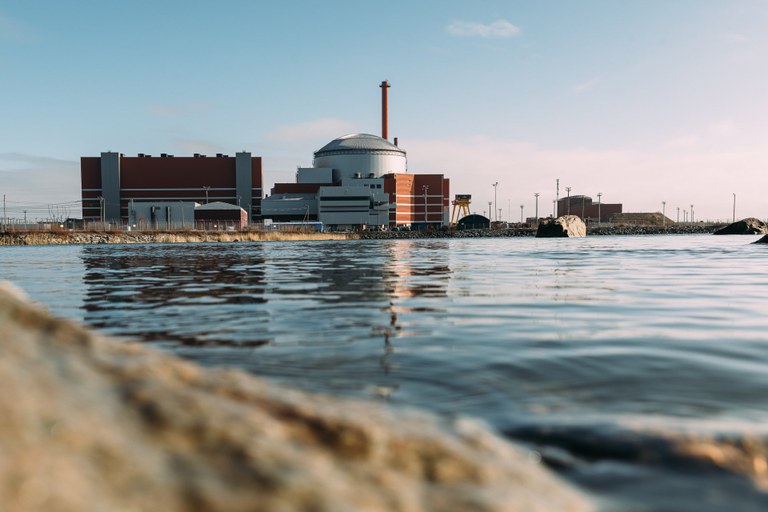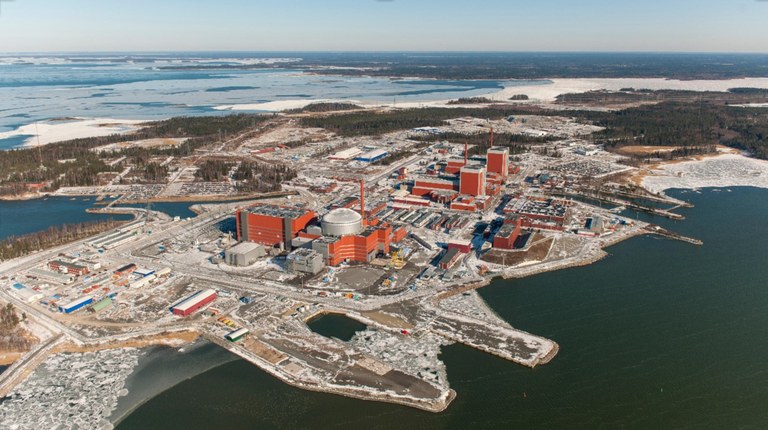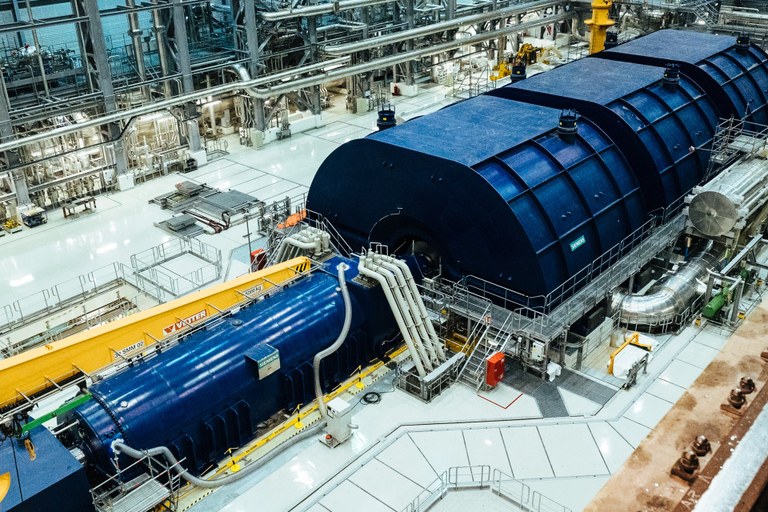Finland's largest industrial project finally finished
The Olkiluoto nuclear power plant has been called a forever project. The first two reactors were built in the 1970s. Now the third reactor has come online, after more than 30 years.
Nuclear power has become crucial to Finland’s energy supply, but opponents point out another forever issue. Nuclear waste is being stored deep in the bedrock nearby and has to be kept safe for a hundred thousand years.
Europe’s energy policy got a wake-up call when Russia launched a full-scale invasion of Ukraine. All of a sudden, national energy self-reliance became deadly important.
Huge expectations from Europe’s largest nuclear power plant
Finland had great expectations for the third nuclear reactor at Olkiluoto – Europe’s largest with a capacity of 1,600 megawatts. It would see Finland through the first winter without Russian energy and replace the Russian electricity import which was halted.
But it was a disappointment. The project has been dogged by delays all the way to the end. Security investigations have time and again unveiled issues with construction, building materials and machinery.
Finland still avoided sudden electricity cut-offs or rationing. The winter of 2023 was not too cold and Finns had learned how to save energy. But the prices became considerably higher than before.
Now though, it is ready. On 16 April 2023, the final test run of the nuclear reactor was a success. One week later, the energy company Teollisuuden Voima (Industry power) took over the new power plant, constructed by Areva. Commercial energy production has begun.

The nuclear power plant is on the Finnish west coast, some 100 kilometres north of Turku. Photo: TVO
The hope now is for electricity prices to return back to normal levels when Finland once again is self-reliant on electricity. In the meantime, the country needs to import electricity from Sweden and Northern Norway, which has threatened to stop its export.
The Swedish news provider Näringslivet envisages lower electricity prices when Finland’s balance between electricity produced and consumed improves considerably thanks to Olkiluoto. When the new reactor reaches max production, it will have large consequences for Finland and the Nordic energy system, writes the newspaper.
The baguette municipality
Olkiluoto is situated in the small municipality of Eurajoki with less than 10,000 inhabitants. Nuclear power has meant an expanding population, internationalisation, tax revenues and good times for the municipality, which is said to be debt-free. Eurajoki has been jokingly called “Finland’s most electric municipality”.
The power plant’s owners Teollisuuden Voima are owned by Finnish industry groups and energy companies which also share the energy production.
The first nuclear power units were built by Swedish Asea-Atom in the 1970s, but the third reactor was built by the French nuclear power plant developers Areva.
The company brought in hundreds of French workers. A French school was built in the municipality and baguettes popped up in the bakery section next to Finnish rye bread.

The new reactor is in the front of the two older ones in the picture above. It is the most powerful reactor in Europe and the third most powerful in the world. Photo: TVO
The long delay meant extended working contracts for staff. More than 4,500 people from 80 nations have been involved during the long construction period.
The nuclear power plant still employs hundreds of staff at Olkiluoto. The work with permanent storage deep in the bedrock is also continuing. Finland is solving nuclear power’s great challenge, the permanent storage of spent fuel rods.
The waste will be placed in steel and copper capsules and stored in bentonite clay in underground tunnels 450 metres down in the stable Finnish bedrock. This is where all Finnish nuclear waste will be stored and the final seal will be put in place in around 100 years from now.
The state depends on Olkiluoto and Lovisa
Half of Finland’s energy needs are covered by nuclear power. The three Olkiluoto reactors will produce 30 per cent of the country’s energy needs.
The second Finnish nuclear power plant lies in Lovisa, on the coast east of Helsinki. It was constructed by the state but is now owned by the Fortum energy group, in which the state owns a majority share.
Last winter, the government decided to extend Fortum’s operating license for the two nuclear reactors in Lovisa to 2050. The original licence would have seen them shut down between 2027 and 2030.
The government argues that the Lovisa nuclear power plant is needed to secure Finland’s electricity supply. The power plant produces around 10 per cent of Finland’s electricity needs.
Russian influence
The Finnish Radiation and Nuclear Safety Authority says Fortum is able to carry on safely operating the reactors in Lovisa. They are a Soviet construction with many Western safety amendments. The protective shield has been made thicker using Finnish steel. Computers and various equipment have been delivered by companies like Westinghouse, Nokia and Siemens. Still, much is in its original state.

The new reactor's turbine hall. Photo: TVO
The nuclear power plant has been dependent on Russian uranium fuel, but Fortum is now looking into the possibility of transitioning to a new type of fuel from the West. The waste used to be sent back to Russia, but the final storage of low and medium-active waste is now being done in the bedrock around the power plant.
In Lovisa, like in Olkiluoto, there have been hopes and plans for a third reactor, but the project has hit costs issues and questions around the final storage of waste. The government turned down Fortum’s application for a third reactor in 2010. It was said that the Fukushima accident did not improve the chances for a new application.
Kreml offered to build a third reactor in Lovisa in 2015, but the matter was not taken further.
A new project in the north stopped
Instead, a completely new nuclear power plant was to be built in Pyhäjoki in the north of Finland. The Finnish energy company Fennovoima would build a plant together with the Russian Rosatom’s daughter company RAOS Projects, which also owned one-third of the project. This was due to come online in 2029.
Work began, the shaft for the nuclear reactor was excavated, cables were laid and infrastructure for seawater hydraulics was prepared. But now the project has been stopped.
Fennovoima terminated its contract, citing significant delays and RAOS’ inability to deliver the project Hanhikivi 1. The war in Ukraine had further exacerbated the risks of the project, according to the company.
For the Finnish owners, continued cooperation became even more difficult when Rosatom took over the Ukrainian nuclear power plant in Zaporizjzja. The Finnish Minister of Economic Affairs Mika Lintilä considered it to be impossible to carry on with the project which had still not received all its permits.
A major owner that has violated all international agreements by taking over another state's nuclear power plant cannot possibly get a permit to run a nuclear power plant in Finland, said Lintilä during a parliamentary debate.
Small-scale nuclear power next?
Finland is now looking for alternative solutions and has not ruled out finding someone else to finish construction in Pyhäjoki. But first, a range of legal challenges surrounding the abandoned Russo-Finnish cooperation must be solved.
Fortum owns the nuclear power plant in Lovisa and one-quarter of the Olkiluoto plant. It also has a considerable share in the Swedish nuclear power plants in Oskarshamn and Forsmark. Fortum is known as a leading Nordic fossil-free energy company and it is assessing the possibilities for new nuclear power in the Nordics.
Fortum and Outokumpu are cooperating on new, small-scale nuclear power projects, like SMR in Finland. The aim is to reduce CO2 emissions from Outokumpu’s stainless steel production in Northern Finland.
In addition to wind, solar and hydro, energy-intensive industries and the whole of society need stable and fossil-free electricity production, the two companies argue. Nuclear power is considered to be the only alternative.
Opposition has faded
Several political parties and civil organisations have traditionally been opposed to Finnish nuclear power. But the opposition has faded. Greenpeace has said it will no longer take action against nuclear power. The organisation has held many protests over the years, including in Olkiluoto.
Satu Hassi, Minister of Environment from the Green League in 2002, resigned in protest when the government decided to allow the construction of a third reactor in Olkiluoto. The same thing happened in 2014 when the government was due to give the go-ahead for the Pyhäjoki nuclear power plant.
Today even the Green League supports nuclear power, although the party is still concerned about costs and risks.
Many have pointed out the strange situation as Germany closes its three remaining nuclear power plants nearly the same as Finland opens its new one.
More nuclear power to save the planet?
Russia’s war in Ukraine has definitely impacted Finnish energy policy. When the National Coalition Party leader Petteri Orpo started government negotiations after his party’s election win in April, nuclear power was an issue. How were the parties prepared to create conditions for new investments in nuclear power and also for small-scale nuclear power?
Orpo asked the parties whether they were prepared to push Finland’s climate neutrality and support an increase in Finnish companies' environmentally friendly exports. All the parties answered in the affirmative and the result can be seen in the new government programme.
- Olkiluoto nuclear power plant
-
- Lies on the Finnish west coast some 100 kilometres from Turku.
- The first and second units are the same models of boiling water reactor as those at Swedish Forsmark, made by Asea Atom. They were built in the 1970s.
- Construction of Olkiluoto 3 began in 2005 and it was due to go online in 2009.
- This is an EPR pressurised water reactor, a new French model that had yet to be tested at the start of construction. The reactors were delivered by French Areva and German Siemens.
- The new reactors came online at the end of April 2023, but planning started in the 1990s. The government agreed to the expansion in 2002.
- This is Finland’s largest industrial project. The total costs are estimated to be 11 billion euro. Finish media have also called it the eighth-largest construction project in the world.
 Follow us on Facebook
Follow us on Facebook
